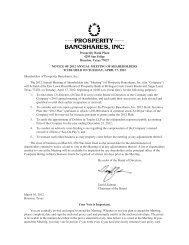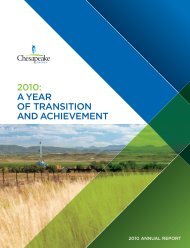goodrich petroleum corporation - RR DONNELLEY FINANCIAL
goodrich petroleum corporation - RR DONNELLEY FINANCIAL
goodrich petroleum corporation - RR DONNELLEY FINANCIAL
You also want an ePaper? Increase the reach of your titles
YUMPU automatically turns print PDFs into web optimized ePapers that Google loves.
GOODRICH PETROLEUM CORPORATION AND SUBSIDIARY<br />
NOTES TO CONSOLIDATED <strong>FINANCIAL</strong> STATEMENTS<br />
natural gas balancing when we have sold more or less than our working interest share of natural gas production,<br />
respectively. At December 31, 2011 and 2010, the net liability for natural gas balancing was immaterial.<br />
Differences between actual production and net working interest volumes are routinely adjusted.<br />
Derivative Instruments—We use derivative instruments such as futures, forwards, options, collars and<br />
swaps for purposes of hedging our exposure to fluctuations in the price of crude oil and natural gas and to hedge<br />
our exposure to changing interest rates. Accounting standards related to derivative instruments and hedging<br />
activities require that all derivative instruments subject to the requirements of those standards be measured at fair<br />
value and recognized as assets or liabilities in the balance sheet. Changes in fair value are required to be<br />
recognized in earnings unless specific hedge accounting criteria are met. We have not designated any of our<br />
derivative contracts as hedges, accordingly; changes in fair value are reflected in earnings.<br />
Income Taxes—We account for income taxes, as required, under the liability method. Deferred tax assets<br />
and liabilities are recognized for the future tax consequences attributable to differences between the financial<br />
statement carrying amounts of existing assets and liabilities and their respective tax bases and operating loss and<br />
tax credit carry-forwards. Deferred tax assets and liabilities are measured using enacted tax rates expected to<br />
apply to taxable income in the years in which those temporary differences are expected to be recovered or settled.<br />
The effect on deferred tax assets and liabilities of a change in tax rates is recognized in income in the period that<br />
includes the enactment date. Deferred tax assets are reduced by a valuation allowance when, in the opinion of<br />
management, it is more likely than not that some portion or all of the deferred tax assets will not be realized.<br />
We recognize, as required, the financial statement benefit of an uncertain tax position only after determining<br />
that the relevant tax authority would more likely than not sustain the position following an audit. For tax positions<br />
meeting the more-likely-than-not threshold, the amount recognized in the financial statements is the largest benefit<br />
that has a greater than 50 percent likelihood of being realized upon ultimate settlement with the relevant tax authority.<br />
Earnings Per Share—Basic income per common share is computed by dividing net income available to<br />
common stockholders for each reporting period by the weighted-average number of common shares outstanding<br />
during the period. Diluted income per common share is computed by dividing net income available to common<br />
stockholders for each reporting period by the weighted average number of common shares outstanding during the<br />
period, plus the effects of potentially dilutive stock options and restricted stock calculated using the Treasury<br />
Stock method and the potential dilutive effect of the conversion of shares associated with Series B Convertible<br />
Preferred Stock, 3.25% Convertible Senior Notes due 2026 and 5% Convertible Senior Notes due 2029.<br />
Commitments and Contingencies—Liabilities for loss contingencies, including environmental remediation<br />
costs, arising from claims, assessments, litigation, fines and penalties, and other sources are recorded when it is<br />
probable that a liability has been incurred and the amount of the assessment and/or remediation can be<br />
reasonably estimated. Recoveries from third parties, when probable of realization, are separately recorded and<br />
are not offset against the related environmental liability.<br />
Concentration of Credit Risk—Due to the nature of the industry, we sell our oil and natural gas production<br />
to a limited number of purchasers and, accordingly, amounts receivable from such purchasers could be<br />
significant. The revenues compared to our total oil and natural gas revenues from the top purchasers for the years<br />
ended December 31, 2011, 2010 and 2009 are as follows:<br />
Year Ended December 31,<br />
2011 2010 2009<br />
Largest purchaser ............................................... 11% 29% 32%<br />
Second largest purchaser .......................................... 10% 17% 19%<br />
Third largest purchaser ........................................... 9% — 10%<br />
* The three largest purchasers for 2009, 2010 and 2011 have consisted of different companies each year.<br />
68











